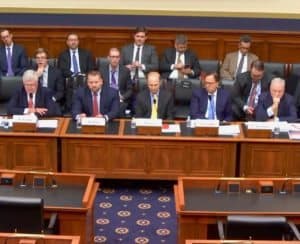In the Fall of 2017, the US Department of Treasury published a document entitled, “A Financial System That Creates Economic Opportunities – Capital Markets.” This comprehensive overview of the current regulatory environment regarding capital formation is probably the best publication I have ever seen produced by a governmental agency in a very long time.
The document provided a roadmap for both Congress and federal regulators as to the issues that needed to be addressed to improve access to capital for both the smaller and larger firms. Online capital formation, under the three crowdfunding exemptions (Reg D 506c, Reg A+, Reg CF) created by the JOBS Act of 2012, received a review and the authors pretty much nailed it with a couple of exceptions. There is plenty more in the Treasury document that goes beyond online capital formation that targets other pressing concerns, but let’s focus on the three securities crowdfunding exemptions for now.
But in the ensuing months what has the US government accomplished? That’s a very good question.
 First of all, Treasury recognizes the vital nature of small business and the importance of access to capital to power a robust and innovative economy. Treasury states that “access to capital is a persistent challenge for small and young companies.” In contrast to larger firms, it is far more difficult for smaller companies to tap the capital markets. This is important as smaller firms create the vast majority of new jobs and thus wealth for individuals. One symptom of this chronic problem is that IPOs of smaller firms have vaporized.
First of all, Treasury recognizes the vital nature of small business and the importance of access to capital to power a robust and innovative economy. Treasury states that “access to capital is a persistent challenge for small and young companies.” In contrast to larger firms, it is far more difficult for smaller companies to tap the capital markets. This is important as smaller firms create the vast majority of new jobs and thus wealth for individuals. One symptom of this chronic problem is that IPOs of smaller firms have vaporized.
A review found that IPOs with an initial market capitalization of $75 million or below constituted 38% of IPOs in 1996. By 2012, this number had declined to only 6% of IPOs. During this same time period, large IPOs – those with an initial market capitalization of $700 million and more – grew from 3% of IPOs in 1996 to 33% in 2012.
The challenges facing smaller companies are driven in part by increased regulatory burdens. In past years, compliance requirements have ballooned. This inflicts not just a cost upon the firms but a cost on society as a whole. While additional regulation may be, in fact, well intentioned – too frequently rules are not right sized or simply not well thought out.
The JOBS Act of 2012 was signed into law by the Obama administration in recognition of the challenges of smaller firms. This law created the exemptions that allowed for online capital formation while recognizing that times have changed and technology needs to be embraced.
First, let’s highlight what the Department of Treasury recommended for the three iterations of crowdfunding in the US.
Regulation A+
Treasury believes that Reg A+, or Title IV of the JOBS Act, has been a success – especially when you compare Reg A+ to old Reg A: a securities exemption that no one utilized due to its obtuse rules.
In the year following implementation of Reg A+, over 140 companies filed with the SEC to use the exemption. This number has since risen dramatically. By comparison, there were just 27 qualified Reg A offerings in the preceding four years. But while the exemption has clearly been improved, it can be better. Treasury believes that expanding Reg A+ eligibility to include Exchange Act reporting companies (companies that already trade on an exchange) will help to lower the cost of capital for these firms.
Additionally, the JOBS Act compells the SEC to review the Tier 2 offering limit every two years. Thus, the SEC may increase the cap without Congressional action and Treasury believes it is time to bump this one up a bit to $75 million.
Regulation CF
 Title III of the JOBS Act was inexplicably entitled Regulation Crowdfunding and perhaps received the most hype and media attention. The smallest of the crowdfunding exemptions, issuers may raise a max amount of $1.07 million. Since implementation approximately $100 million has been raised – mainly by FINRA regulated “portals.” While some industry participants remain positive about this segment of online capital formation, truth be told, the total raised to date is anaemic and disappointing. The regulatory cost, limitations on investment, and other unnecessary hurdles, have hobbled a well intentioned exemption. Perhaps this is simply a reflection of the governmental knee jerk response to focus on investor protection. Some industry observers believe Reg CF suffers from a negative selection bias as more scalable firms look to use other, less cumbersome exemptions.
Title III of the JOBS Act was inexplicably entitled Regulation Crowdfunding and perhaps received the most hype and media attention. The smallest of the crowdfunding exemptions, issuers may raise a max amount of $1.07 million. Since implementation approximately $100 million has been raised – mainly by FINRA regulated “portals.” While some industry participants remain positive about this segment of online capital formation, truth be told, the total raised to date is anaemic and disappointing. The regulatory cost, limitations on investment, and other unnecessary hurdles, have hobbled a well intentioned exemption. Perhaps this is simply a reflection of the governmental knee jerk response to focus on investor protection. Some industry observers believe Reg CF suffers from a negative selection bias as more scalable firms look to use other, less cumbersome exemptions.
So what does Treasury believe?
The obvious one is to boost the cap to $5 million (or more). The initial one million cap was little more than arbitrary and was not reflective of seed stage funding rounds in the US – not to mention later funding efforts.
Treasury states:
“Participants cited regulatory constraints, such as disclosure requirements and issuance costs, as well as structural factors, such as the challenges associated with having a large number of investors, as potentially limiting the use of this capital raising method. Some participants also expressed concern that unless crowdfunding platforms can demonstrate clear advantages relative to the ease and availability of private placements, such as meaningfully increasing the amount of investor capital available from unaccredited investors, crowdfunding may lead to adverse selection where only less-attractive companies pursue funding from less sophisticated investors, who may lack the expertise to properly evaluate such investments.”
 To mitigate some of these legislative shortfalls, Treasury recommends the inclusion of single purpose crowdfunding vehicles (or SPVs), to mitigate unwieldy cap tables and help professional investors engage. A similar availability has worked quite effectively in the UK and with leading global crowdfunding platforms like OurCrowd based in Israel.
To mitigate some of these legislative shortfalls, Treasury recommends the inclusion of single purpose crowdfunding vehicles (or SPVs), to mitigate unwieldy cap tables and help professional investors engage. A similar availability has worked quite effectively in the UK and with leading global crowdfunding platforms like OurCrowd based in Israel.
By facilitating an option for smaller investors to participate alongside professional Angels or VCs, retail types can benefit from a superior level of vetting (and thus enhance investor protection concerns). Aligning interests between both professional and retail investors, along with the issuing platform, can make this exemption far more powerful and beneficial to all. Some international platforms commit to only allowing same terms for both retail and professional investors, a requirement that enhances investor protection for smaller participants. The US can and should enable the same under Reg CF.
Currently, accredited investors are capped on the amount they may invest. This makes absolutely no sense at all and it is odd that this requirement ever made it through the SEC rule making process. Treasury says toss this one out.
Treasury also recommends that Reg CF rules be amended to have investment limits for retail investors based on the greater of annual income or net worth for the 5% and 10% tests, rather than the lesser as it stands now.
Regulation D 506c
Accredited crowdfunding has been the most utilized exemption so far. Title II of the JOBS Act provided for “general solicitation” for Reg D private placements. This meant that issuers were not allowed to advertise or share on social media offerings for securities in firms that filed with the SEC.
The most pressing problem with Reg D is the fact that this exemption disenfranchises the vast majority of the population as only accredited investors may participate. The ham fisted attempt at saving people from themselves has allowed the wealthier members of the population to become more affluent while cutting out those individuals less fortunate. Basing a rule on the size of ones bank account is wrong at best and discriminatory at its worst. Treasury says the definition of an accredited investor should be broadened. It’s wonder that the government has let this exclusionary definition remain at all.
What Has Congress and the SEC Accomplished Since
Little really. Some industry observers believe that most, if not all, of these recommendations can be accomplished by the SEC without Congressional action. But the partisan environment on the Hill can act as a barrier for the SEC to do what’s right as what is right is not always easy. Or perhaps the SEC is just too caught up with other priorities (like ICOs perhaps).
 Some members of Congress have attempted to address these challenges but, once again, parochial relationships and the inability to get bipartisan support, necessary for just about any bill to pass into law, is a vexing issue.
Some members of Congress have attempted to address these challenges but, once again, parochial relationships and the inability to get bipartisan support, necessary for just about any bill to pass into law, is a vexing issue.
Unfortunately, some recalcitrant Members just don’t care. Other’s don’t want to take the time and understand the issues – even when it would be beneficial to their constituents.
Between Congress and the SEC, frankly, it is a bit of a disappointment.
But hope does persist.
Currently, there are multiple bills that are climbing the legislative process that stand a good chance of being signed into law that may address some of the shortcomings mentioned above.
A change in the definition of an accredited investor passed the House by a voice vote last year. A very encouraging sign. A bill to increase the cap on Reg A+ to $75 million, and another to allow reporting companies to use the exemption, are churning through the legislative process as well. There are others in the queue and we expect to see more.
Cost and Complexity Kills
It is a truism that regulatory complexity adds cost and the law of unintended consequences means issuers simply follow a path that is easier for them to accomplish their goals. Treasury has provided a very good roadmap for Congress and the SEC to follow. Fewer unproductive rules that kill innovation, easier access to capital for smaller firms, and more opportunity for smaller investors is the goal. Let’s just hope the federal government can act and pursue Treasury’s recommendations. It will benefit us all.


